SPECIAL
FOCUS: NORTH AMERICAN OUTLOOK
North American drilling:
Growing, but at a slowing rate
United States by World
Oil staff; Canada by Robert Curran, Calgary;
Mexico by Sergio M. Galina Hidalgo, Mexico City
US DRILLING
The Boom continues
A couple of years ago, we thought that
the price-led expansion would be constrained, either by lack of personnel,
lack of rigs or rig components, lack of prospects, or lack of some
critical well construction element, such as pipe. We were wrong.
The resolve to find ways around these obstacles prevailed. But, there
are clear signs that the rate of well drilling is slowing. There
is talk of stacked rigs-normally a
sure sign of trouble. But the Baker Hughes rig count keeps climbing.
The explanation for these two seemingly incongruous facts is that newbuilds
have been added at a faster rate than the rise in the rig count. This
increase has been a modest 5.6% the first seven months of the year,
which is about a third of the rig count increase in 2006.
Since this is a mid-course correction
of our February forecast, we see that we were a bit too optimistic
at that time, when we forecasted 52,208 wells. Based on operator
surveys, state data, well permits, rig counts and other sources,
we now forecast that 2007 will see 49,215 wells drilled-a spare 0.6% increase over 2006’s
48,929 wells.
Operator surveys. This update of World
Oil’s
survey includes 18 major US drillers (integrated companies and independents
with large drilling programs) and 132 independents. The optimism
expressed in February continues, but has tempered the total number
of wells planned for 2007.
| Midyear
revision, 2007 US drilling forecast |
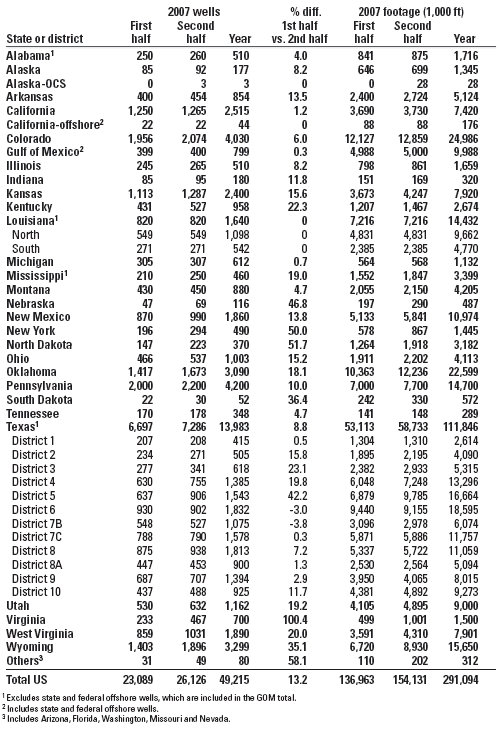 |
|
What
18 US major drillers1 plan for 2007-Midyear
update
Click table to enlarge. |
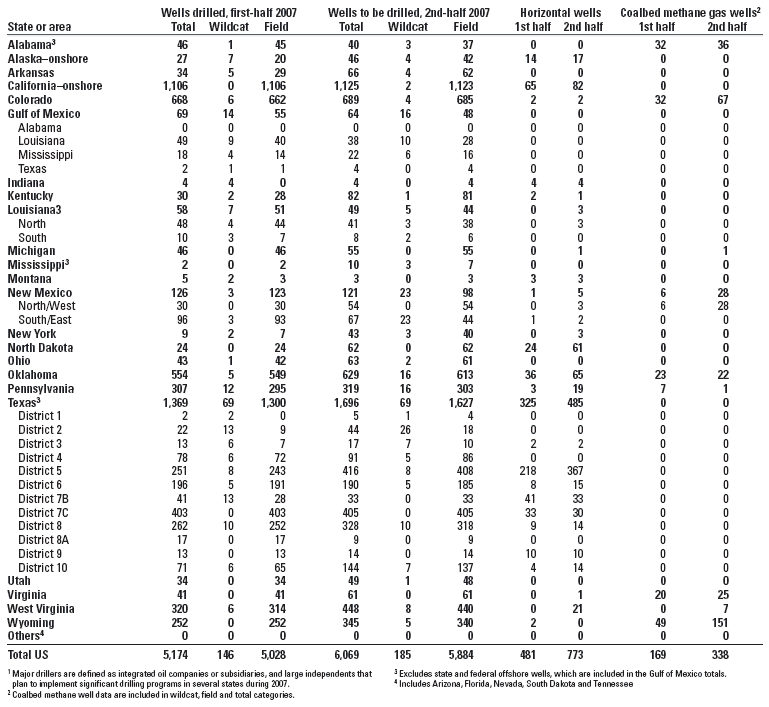 |
|
Major downward revisions from our February
survey occurred in California (520 wells), Colorado (865 wells),
Kentucky (1,252 wells-possibly
a reporting error) and Wyoming (641 wells). Upward revisions were modest
and not sufficient to overcome the general pullback. Some of the stronger
upward revisions were in Arkansas (204 wells), Pennsylvania (50 wells),
Tennessee (37 wells) and Texas (169 wells). Even though this survey
is not collected scientifically, the responses gathered represent a
very large sample of major drillers’ plans.
Rigs. Counts often show large differences
among the rig-counting services (such as Baker Hughes, Smith International
and RigData), which is something that we see routinely, given the
different methodologies. We see similar differences between the rig
counts and the state agencies’ well
data. Sometimes, even when all rig counts go in the same general direction
and magnitude, the well-count data show the opposite trend. This is
usually due to rigs too small to be counted by most surveys, especially
when drilling coalbed methane. Alternatively, when an area is experiencing
a rapid change in drilling activity, the reporting agencies become
swamped and lag in their ability to gather and report well data.
Newbuilds have strongly entered the market
and in some cases have had a downward effect on rig efficiency (wells/rig)-seasoning
crews takes time. There are some areas that could use more rigs, but
the dayrates being charged are pulling rigs to the most prospective
regions, leaving some operators and trends waiting for a softening
rig market before continuing development plans.
As of mid-July, the Baker Hughes’ and Smith International’s
working rig counts have increased about 6%, adding some 100 rigs to
around 1,730 rigs. There appear to be enough rigs to sustain present
drilling levels.
Prices. The general picture, as far as gas prices go, is that demand
is soft, supply is easily adequate and storage levels remain stubbornly
high. The situation is identical to last year, when traders were hoping
for either a very hot summer or an active hurricane season to reduce
storage levels.
What
132 US independents1 plan for 2007-Midyear
update
Click
table to enlarge. |
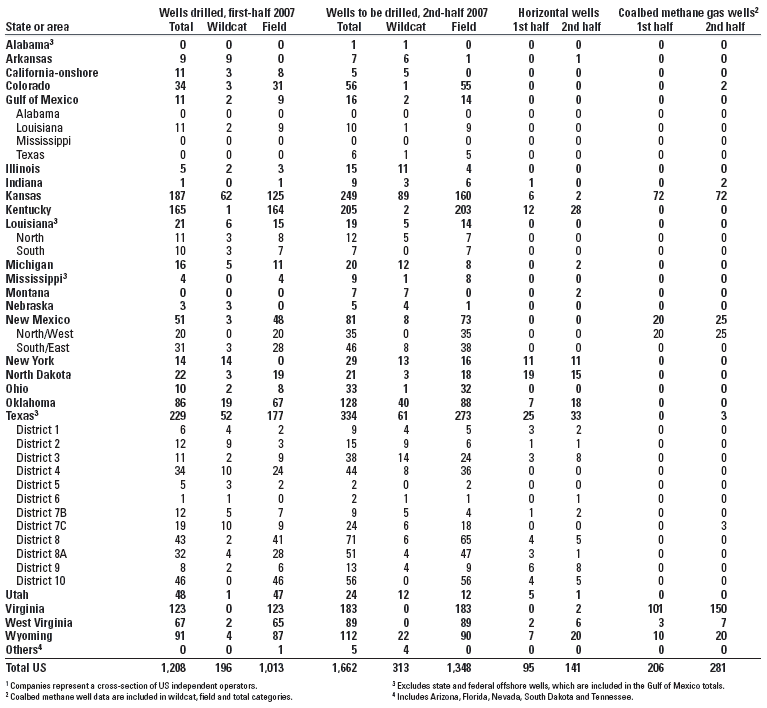 |
|
Adding to supply, the 1-Bcfd-capacity
Independence Hub saw first gas in late July. It will begin a ramp-up
process as it brings on 14 wells over the coming months, each capable
of producing in the 50-MMcfd range. If there is a low-price scare
and it results in significantly reduced drilling, such a downturn
would be short lived, because unconventional wells are a growing
portion of supply (40%) and storage levels would quickly be reduced.
In the Rocky Mountain region, a price scare has already occurred
with wellhead prices dropping as low as $1.87/MMBtu in selected markets,
but averaging $4.25/MMBtu year-to-date, according to the Energy Information
Agency’s Natural Gas Weekly Update.
According to Citigroup’s E&P
Spending Survey: 2007 Midyear Update, the industry is using planning
prices of $57.05/bbl for WTI crude and $7.08/Mcf for natural gas.
Compared to last year, these expectations are up $3.52/bbl for oil
and down $0.25 for natural gas. Overall, their survey reveals that
global industry spending is advancing at a 7% rate; however, US spending
is up 5.7% while Canadian spending is down 6.6%. It is noteworthy
that much of this increase goes into higher spread rates, not just
more boreholes.
Area highlights. Drilling is up overall
from last year, but down from our forecasted numbers presented in
February’s
issue. On land, the drilling market has separated into two distinct
segments, conventional and unconventional drilling (see page 67).
Conventional drilling fluctuates with the seasons and/or commodity
price, while unconventional activity seems unaffected by either at
this time. Most unconventional drilling is horizontal, seeking coal
bed methane or shale gas.
The big theme this year is that coalbed
methane drilling is down from 2006, particularly in Kansas (off 641
wells) and Wyoming (off 605 wells). The reasons vary (see page 91).
In Kansas, CBM drilling soared to 1,828 wells in 2006, and this year
the frenzy is pulling back to a projected 570 wells. In Wyoming,
environmental problems with dewatering threaten to increase costs
by requiring more reuse, treatment, reinjection, or some combination
of these. Add to this the fact that the Rocky Mountain area is overproducing
relative to its infrastructure. Local storage levels are very high,
and pipeline capacity is not sufficient for exporting to big, gas-thirsty
markets. The Rockies Express (REX) pipeline is partly complete, from
Meker, Colorado, through the Cheyenne hub and into Missouri at this
time. But the full length won’t be finished
all the way to Clarington, Ohio, until June 2009, according to the
schedule.
What
19 Canadian drillers plan for 2007-Midyear
update1
Click
table to enlarge. |
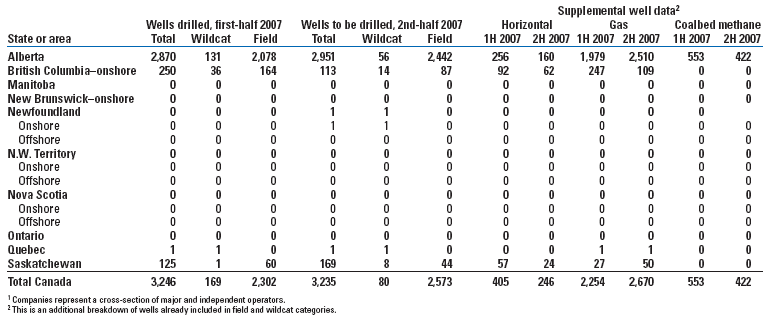 |
|
| Canadian
drilling, 2007 provincial forecasts-
Midyear update1 |
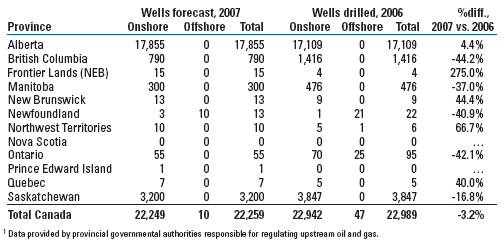 |
|
The pullback in CBM is matched by increases in unconventional shale
gas drilling in the Barnett Shale in North Texas and the Fayetteville
Shale in Arkansas (see page 23). The Fayetteville trend has been very
active this year and one operator, Southwestern Energy, has drilled
68 wells thus far in 2007, keeping 20 rigs drilling in the play.
In the Gulf of Mexico, operators are on a pace to drill 799 new wells,
down slightly from our February estimate of 804 wells and from the
2006 total of 813 wells. GOM rig count continues to drop (see page
59) as rigs leave the Gulf for better contracts elsewhere. But footage
estimates are increasing, as operators drill deeper wells on the shelf
and in new deepwater trends.
Most of Texas’ drilling will take
place in Districts 5, 6, 7B, 7C, 8 and 9 in the Barnett Shale play.
According to the Texas Alliance of Energy Producers, the Texas PetroIndex
has reached the highest level ever at 227.6, up significantly from
100, its 1995 base-year value. The monthly index uses 25 metrics
including prices, rigs, completions, volume, value and employment,
among others. In comments at a recent press conference, economist
Karr Ingham noted the strong rise in the index over the past few
years capped by a leveling off over the past few months. He found
the leveling significant, since in earlier booms the activity dropoff
occurred suddenly and down substantially over one or two months.
The Alliance thus confirms independently what World Oil has found
in its survey. The industry appears to be reaching a sustainable
high drilling level.
In Ohio, a significant legislative change
occurred that has opened new acreage for development. In September
2004, a law was passed that normalized the distance-from-housing
drilling regulations across the state. Cities had widely varying
distance regulations that were hampering drilling. Now, operators
can drill closer to existing structures uniformly across the state.
According to state officials, 25% of the state’s
new drilling is in these newly opened “urbanized” drilling
areas. The Clinton sandstone, Knox formation and Trenton-Black River
trends will see the most action. World Oil forecasts a 12.5% increase
in drilling to over 1,000 wells.
One of two oil gatherers is having problems and may go out of business
in Tennessee. Other oil gatherers are stepping in to help, but transport
distances are driving up costs and reducing potential profits for producers.
This has dampened drilling activity and reduced anticipated drilling
by 47 wells to 395 wells for 2007.
Oklahoma will see a nearly 12% increase in drilling led by the deeper
western basins. Most rigs are under contract and locked up, leaving
few available for small operators to use on one- or two-well prospects.
Rigs are also being drawn out of state south to the Barnett Shale play.
The state increased permit costs, making it a bit more expensive to
drill, and large operators have leased major prospective acreage blocks,
which is squeezing out the smaller players. Even with these constraints,
the state will see over 3,000 wells drilled.
Rig counts are stable in Utah at 37-40
rigs. These rigs are mostly drilling development wells, but permits
are down slightly. According to state officials, the Ferron CBM play
in Carbon and Emery counties is drilled out. Still, the state will
see a 16% increase in wells drilled.
Drilling in Colorado has shifted between
the various basins over time. At one time, the D-J basin was the
hot spot; now the Piceance basin is the operator’s choice.
They are seeking the Williams Fork and Mesa Verde formations as preferred
targets. Well reports are down according to state officials, likely
due to lags in reporting CBM drilling. The San Juan and Raton basins
still have solid CBM activity. But, World Oil anticipates a slowing
in activity, dropping almost 900 wells from our February estimate.
The state will still see over 4,000 wells drilled in 2007.
Coalbed methane drilling has been a mainstay
of Wyoming’s activity.
This year will see a significant slowing. While we had anticipated
a 4% increase in our February forecast, drilling has slowed markedly
and we have reduced our forecast almost 13%, dropping 487 wells from
the 2006 figure. The state will see almost 3,300 wells drilled.
Much of this retrenchment is driven by
a drop in wellhead gas price. Early in the CBM play, gas was selling
for $7.60/Mcf, but now it has dropped to as low as $2.40/Mcf in some
places, greatly reducing the economic incentive to drill. Pipeline
capacity is the constraint and that won’t be eased until after
the REX pipeline is fully up and running in two years.
Another issue is the disposal of produced
waters. Many of Wyoming’s
rivers flow into Montana and the differing state environmental limits
are creating cross-border problems. The states must come to some agreement
and producers must take more care with their water disposal, but it
has not yet caused a significant drilling constraint.
About these statistics. World
Oil’s tables are produced aided
by data from a variety of sources, including the American Petroleum
Institute, ODS-Petrodata Group, the Texas Railroad Commission and most
other state regulatory agencies. In addition, 150 operating companies
with drilling programs responded to this year’s survey. Our survey
is not scientifically randomized and new environmental and political
challenges may emerge at any time. Please note credits and explanations
in table footnotes.
World Oil editors try to be as objective
as possible in this estimating process to present what they believe
is the most current data available. It is realized that sound forecasting
can only be as reliable as the base data. It should be noted that
well counting is a dynamic process and most historical data will
be updated over a period of several years before the “books are closed” on
any given year.
CANADA
It had to happen. When the oil patch starts surging, there are always
people who predict that the inevitable downturn in activity is imminent.
But after four years of unprecedented growth, the downturn still came
as a bit of a shock.
Economics. The culprit was a prolonged
spate of soft natural gas prices. Also, the Canadian dollar, surging
to levels not seen in three decades, is virtually at par with the
American greenback, substantially decreasing the value of Canadian
exports. The shortage of skilled workers continues to be a source
of concern. And there are a couple of political concerns: proposed
federal and provincial environmental controls and Alberta’s
review of its royalty structure.
The increasing and unanticipated strength of the Canadian dollar is
proving troublesome for producers. Despite a surge in stock values
on the Toronto Stock Exchange this year, profits are expected to drop
for the majority of producers. They rely on the premium gained by exporting
their products for American dollars. Some industry experts maintain
that every 1% increase in Canadian Loonie value costs producers $1.3
billion annually.
An ongoing source of concern remains the lack of skilled workers.
Alberta Employment recently released data that indicate a shortfall
of 40,000 oil workers in the province within eight years.
And yet many of the fundamentals driving
the upsurge over the past several years remain firmly in place. Canadian
producers recorded first-quarter 2007 cash flows just slightly lower
than the first quarter of 2006. Surging world demand has sustained
remarkably bullish oil prices. Concurrently, declining North American
supplies of conventional crude have convinced producers that the
multi-billion-dollar investments necessary to recover a portion of
Alberta’s massive
oil sands developments are worthwhile.
Politics. The belief in the worthiness
of developing oil sands remains despite Alberta’s ongoing royalty review, which was launched
by the new provincial administration after increasing public and political
pressure. Since the review’s inception, the industry has mounted
an extremely well-organized, public campaign to convince Albertans-and
Canadians in general-that the current royalty structure is not
only fair, but in fact benefits the province and the country through
encouraging development that boosts the economy.
Skeptics have criticized the review as
little more than a political maneuver from a government that can’t
afford to risk the revenue streams generated by an industry with
record activity.
Industry associations, including the Canadian Association of Petroleum
Producers (CAPP) and the Small Explorers and Producers Association
of Canada (SEPAC), have both argued that spiraling costs paid by producers
have to be considered when assessing the royalty regime. Others, like
the Petroleum Services Association of Canada (PSAC), have said that
the recent downturn in activity proves that changes are not required.
In response, Alberta Premier Ed Stelmach said that his government
will take into account factors like higher costs, the Canadian dollar,
and the unique characteristics of unconventional resources.
On the environmental front, a change appears
to be underway regarding public opinion. Very few Canadians seem
prepared to give up gas-guzzling SUVs or embrace a less energy-intensive
lifestyle. Nevertheless, there is a growing sentiment that “something” must be done about
the environment and, in particular, Canada’s status as one of
the planet’s highest consumers of energy per capita.
Although the federal government has resisted
following through on Canada’s Kyoto Accord obligations, it
has introduced the Regulatory Framework for Air Emissions, a made-in-Canada
solution. It will reduce greenhouse gas emissions 20% by 2020, and
65% by 2050. Not surprisingly, environmentalists are outraged that
the government is not introducing stricter requirements, while some
industry groups are complaining that the goals will cause them (and
the country) economic hardship.
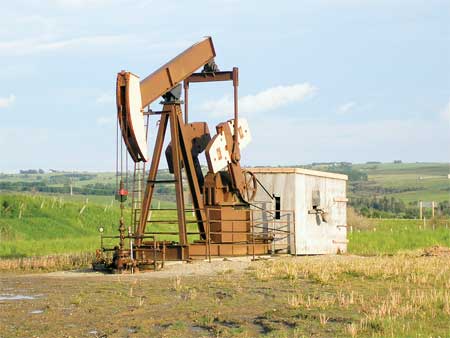 |
Canadian
conventional oil production, symbolized by this
Shiningbank Energy Income Fund (now PrimeWest Energy
Trust) well along Alberta provincial highway 22 near
Cremona, remains in a slow decline, offset by gains in
oil sands output. Photo by Kurt Abraham, Managing/International
Editor. |
|
A report recently released by Environment
Canada also states that unless Ottawa follows with taxes on emissions,
Canada will never hit its targets. Ironically, Canadian Prime Minister
Stephen Harper’s
minority government is also under fire for not adhering to a bill drafted
by the opposition Liberals (and passed by the other opposition parties)
that requires his administration to adhere to Kyoto. The irony, of
course, is that the Liberals originally signed Kyoto, and then did
nothing to follow through while they were in power. The Tories are
not expected to comply, as disregarding the bill would not trigger
an election.
So, at the half-way point of 2007, the Canadian industry faces more
uncertainty than it has for many years. Given the nature of the concerns,
the industry now must address challenges that fall within its influence.
The dichotomy of the price environment
has accelerated an ongoing trend that Alberta has experienced for
many years-the
shift to an industry dominated not just by oil, but by the oil sands.
On the flip side, natural gas development has slowed significantly,
as the first-half slump in gas prices has dramatically affected drilling
plans for the remainder of 2007. Additionally, plans to develop gas
supplies that are still characterized as unconventional in Canada,
most typically coalbed methane, have predominantly been shelved until
gas prices climb out of their current slump.
In fact, the value of oil exports exceeded that of gas for the first
time in many years, according to the National Energy Board. Net revenue
for crude oil exports was about C$25 billion in 2006, compared to $17
billion in 2005 (up 47%); net natural gas revenues were $24 billion,
versus $32 billion the year before (down 25%). Overall, net export
revenues were flat in 2006.
However, over the long term, it seems
unlikely that North America’s
seemingly insatiable demand for gas will abate at any point in the
foreseeable future. But a different long-term concern has been raised
in some quarters about Canada’s gas productive capacity, and
its obligations under the North American Free Trade Agreement.
To date, NAFTA has been upheld by the federal government and the National
Energy Board. However, if supply continues to fall as predicted, there
may be a point in the future when domestic requirements compete with
US demand. It is uncertain how Canada will manage the needs of its
citizens, given the NAFTA requirements.
In this bearish gas-price environment,
a substantial amount of gas drilling has been delayed, but producers
seem optimistic that the trend will reverse itself sooner rather
than later. A hot summer in the US may be all that’s required
to snap prices out of their slump.
Regardless, it is widely accepted that
Canada’s future as an
oil producer is heavily tied to the continuing development of Alberta’s
massive oil sands deposits, claimed as the second-largest oil reserves
in the world.
Even with global crude prices remaining
strong, there are some concerns about the increasing costs associated
with the incredible activity levels and growth in Alberta’s Athabasca oil sands region. Recently,
China National Petroleum Corp. (CNPC) announced that it was reducing
its investments in Alberta’s oil sands, preferring to invest
in Venezuela. Apparently, CNPC was not prepared to wait the necessary
time required in Alberta to develop oil sands holdings, opting for
the more business-friendly Venezuela.
Many other firms are pushing ahead with
their plans, including Houston’s
Marathon Oil, which has expressed interest in pursuing oil sands opportunities.
Among those companies committed to long-term oil sands investment
are Petro-Canada and its partners (UTS Energy Corp. and Teck Cominco
Limited), which have taken the next step in developing its C$14-billion
Fort Hills oil sands mining project, having made the decision to proceed
with project engineering. Once the year-long phase is complete, the
partners will make the final decision on whether or not to proceed
with the project, which will produce 140,000 bpd of synthetic crude
in Phase One, scheduled to be online in 2012. Phase Two would then
ramp production up to 280,000 bpd of synthetic crude by 2014.
As it stands right now, there is still more than C$100 billion committed
to oil sands development over the next decade, despite the present
uncertainty in the Canadian market.
Drilling. On the drilling front, operators punched down 9,913 wells
during first-half 2007 according to the Daily Oil Bulletin. That figure
is down just under 11% from the 11,135 wells drilled in the first six
months of 2006. At this pace, drilling would fall below the 20,000-well
mark for the first time since 2003.
World Oil’s six-month survey of
Canadian drillers seems to uphold that forecast, with most operators
indicating they will drill about the same number of wells in the
second half of the year. Natural gas remains the primary target,
with 76% of the planned wells to drill for gas.
Total second-half drilling is expected to decline by less than 1%,
with the largest decrease in British Columbia (down 55%). Activity
in Alberta will increase slightly in the second half (up 3%), while
drilling in Saskatchewan is expected to increase by 35%.
Rig activity saw an average of 359 units working through the first
six months of 2007, out of a total of 857 rigs available through June,
according to the Canadian Association of Oilwell Drilling Contractors
(CAODC). This is the lowest average number of rigs working since 2002,
and a 31% decrease from 2006. CAODC has also adjusted its 2007 forecast
downward dramatically to 16,339 wells drilled, versus the 19,023 it
predicted last fall. Lower gas prices and very low first-quarter drilling
totals are the main reasons.
Meanwhile, PSAC is less bearish, predicting 19,200 wells will be drilled
in 2007.
Reserves. Daily Oil
Bulletin records indicate
that the Canadian industry replaced natural gas production in 2006,
the first year since 2003 that the replacement ratio did not exceed
20%. Proved reserves replacement was essentially flat, at 4.53 Tcf,
just shy of last year’s production
of 4.55 Tcf. In total, Canadian proved reserves stood at 38.7 Tcf.
M&A activity. One of the offshoots of turbulence in this industry
is an upswing in merger and acquisition activity, and 2007 is no different.
Highlights in the first half of the year include a late-June C$3.5
billion deal to take private the CCS Income Trust, a Calgary-based
service company. The deal was secured by an investor group led by the
company’s president and CEO.
In late May, Pogo Producing Company approved the sale of wholly owned
Northrock Resources Ltd. to Abu Dhabi National Energy Company PJSC
in a cash deal worth US$2 billion. Pogo originally acquired Calgary-based
Northrock for US$1.7 billion in late 2005.
In early May, Calgary’s Husky Energy Inc. acquired Valero Energy
Corp.’s Lima Ohio refinery for US$1.9 billion, subject to regulatory
approval. The refinery’s throughput capacity is 165,000 b/d of
light crude.
Also in May, PrimeWest Energy Trust and
Shiningbank Energy Income Fund agreed to merge in a C$1.25 billion
deal that will create Canada’s
fifth-largest energy trust. The combined entity will have daily production
of 59,000 boed.
Looking ahead, one of the best signals
of industry’s intentions
remains land sales. Bonuses paid by producers through first-half 2007
were substantially lower than those paid in 2006. However, 2006 was
a record year, and it is worth noting that 2007 levels are closer to
what would otherwise be considered normal by Canadian standards. In
fact, the amounts collected still represent the fourth-highest total
in Canadian history. In total, producers paid $983 million through
the first half for mineral rights, down 63% from last year’s
$2.66 billion.
MEXICO
After eight consecutive years of financial
losses, state oil firm Pemex finally reported a net surplus of close
to $4 billion during 2006. This is significant, given that the annual
average loss from 1998 to 2005 was around $3.2 billion. As recently
as 2005, the company reported a net loss of more than $7 billion.
Furthermore, during the same year, the growing debt that the company
accumulated during the mid-1990s outgrew the value of Pemex’s assets. Yet, last year’s
financial result has allowed the company to rebound to a positive equity
value, proving that there is life after death.
One of the main reasons for this remarkable
recovery is the fiscal framework applied to Pemex during 2006. This
structure originated from the new Federal Rights Law approved by
the congress in 2005. Nevertheless, the company’s financial future still looks extremely complicated.
Officials have reported that beginning in 2008, and continuing into
the following decade, Pemex will need around $22 billion of yearly
investment. This figure is astonishingly high compared to the $2.9
billion annual average recorded from 1983 to 2000, or even against
the more adequate average of $10.7 billion achieved from 2001 to 2007.
To reach this level of via the “Pidiregas” financing (debt)
mechanism is highly improbable, because the company’s debt is
already around $110 billion.
In this context, the ideological discussion
over Pemex’s role
as a public monopoly maximizing the value of the country’s resources,
against the apparent need to open the sector to private capital, will
dominate the political debate in the months to come. The solution to
the company’s financial dilemma is not trivial, and it will require
brilliant proposals and a national compromise that takes into consideration
Pemex’s circumstances. It must also consider the government’s
oil income dependency and the federal state’s economic welfare
before either passing a new fiscal reform to provide the company with
more resources, or making the necessary changes in the constitution
to allow the involvement of private capital in E&P activities.
Exploration/drilling. The 656 wells drilled
in the country in 2006 was a hefty number by Mexican standards, but
it was 11.5% less than the total wells drilled the previous year.
In addition, the 69 exploration wells drilled represented a 22% drop
from the 2003-2005 average.
Furthermore, the relatively high 55% success ratio of that period dropped
to 46% in 2006, meaning that both the total number and success ratio
of exploration wells fell in 2006, not good news when one notices that
the country is in a seven-year-long slide of oil and gas proved reserves.
The optimistic note, however, is that the government forecasts a 13%
increase in exploration drilling and a 22% increase in total wells
drilled for the current year.
At the beginning of 2007, proved oil and gas reserves stood at 15.5
billion boe, which yields just around 9.5 years in the reserves/production
ratio. This is the first time since the oil boom of the 1970s that
the ratio has been reported as less than 10 years. Despite the 6.5%
decline in proved reserves from 2005 to 2006, it is interesting to
note that the reserve replacement rate of 41% was the highest reported
since 1998, the initial year of external reserves certification.
Development/production. The average daily
Mexican production peeked at a historic level of 3.38 million bbl
in 2004. Ever since, it has steadily dropped every year, up to a
7% rate by first-half 2007. This behavior coincides with the start
of the decline in Cantarell field, which represents more than half
of the county’s oil production.
The decline is projected to continue at a 14% rate for the next 10
years. This means an annual production loss of about 150,000 bopd.
How and when Pemex will be able to cope with Cantarell’s decline
is yet to be seen, because an important alternative may be to incorporate
production from the Chicontepec region, as well as the GOM’s
deepwater potential. However, the company will require considerable
investment to face the technical challenges of developing such reserves,
which, as noted above, are not an easy alternative to undertake within
the financial situation.
It must be noted that despite the decrease in oil production since
2004, the light oil output, mainly from the Southwest Marine Region
of the GOM, has increased 12%, improving the quality of the Mexican
oil mix from a heavy/light proportion of 73%, down to 67% in 2007.
A similar trend can be observed for natural gas production. It has
not only increased a whopping 33% from 2002 to 2007, but it has also
changed its origin from 30% to 44% non-associated, due to investments
in non-associated gas development in the Northern Region. This development
extends from the GOM coastal plain, in the north-central portion of
Veracuz, to Tamaulipas and Coahuila states south of the border with
the US. 
|








